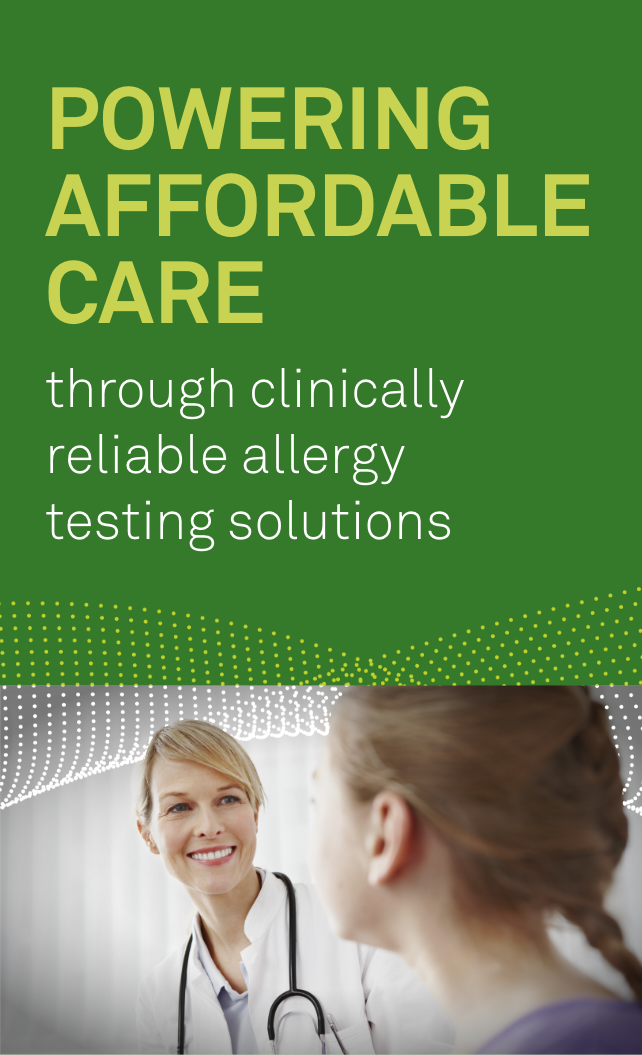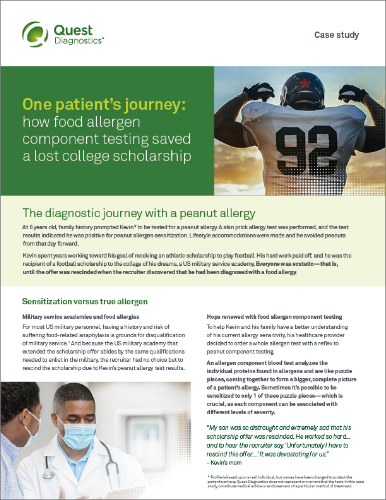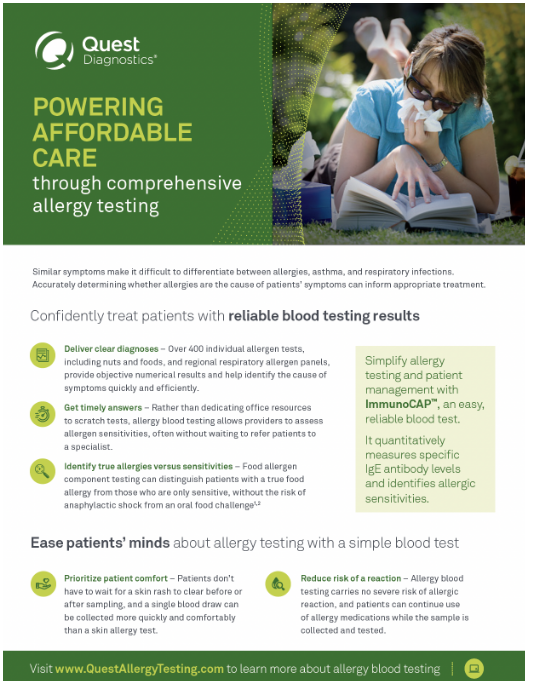|
|
Deliver a diagnosis—Objective numerical results bring clarity to over 400 individual allergens including nuts and foods, as well as regional respiratory allergens. |
|
|
Get timely answers—Rather than dedicating office resources to scratch tests, allergy blood testing allows providers to assess allergen sensitivities, often without waiting to refer patients to a specialist. |
|
|
Prioritize patient comfort—Patients don’t have to wait for a skin rash to clear before or after sampling, and a single blood draw can be conducted more quickly and comfortably than a skin allergy test. |
|
|
Reduce risk of a reaction—Allergy blood testing carries no severe risk of allergic reaction, and patients can continue use of allergy medications while the sample is collected and tested. |
Simplify allergy testing and patient management with ImmunoCAP™, an easy, reliable IgE blood testIt quantitatively measures specific IgE antibody levels and identifies allergic sensitization. |
|
Upper respiratory disorders, including rhinitis, sinusitis, and allergic rhinitis, affect tens of millions of Americans.1 Because the cause of URD symptoms may be viral, bacterial, or allergic, a definitive diagnosis is essential to determine appropriate treatment.
|
|
Nearly two-thirds of patients prescribed antihistamines for their reported allergic rhinitis have symptoms that are not due to allergy2 |
From animal dander to pollens, allergens often add up as each patient has a different level at which they show symptoms. When that level is crossed, the combination of allergens turns into symptoms.13,14 Blood testing for response to whole allergens helps you diagnose pet allergies, as well as other indoor and outdoor allergies, and to prepare a more comprehensive management plan. ImmunoCAP offers a full range of allergen testing.
|
|
Over 49 million Americans are sensitive to dog and/or cat allergens15,16 |
Quest Diagnostics also offers a full range of indoor and seasonal allergy testing, including house dust mites, molds (indoor and outdoor), and pollens, among others
- Stewart M, Ferguson BJ, Fromer L. Epidemiology and burden of nasal congestion. Int J Gen Med. 2010;3:37-45. doi:10.2147/ijgm.s8077
- Szeinbach SL, Williams B, Muntendam P, et al. Identification of allergic disease among users of antihistamines. J Manag Care Pharm. 2004;10(3):234-238. doi:10.18553/jmcp.2004.10.3.234
- CDC. Allergy testing for persons with asthma: frequently asked questions. Accessed September 4, 2020. https://www.cdc.gov/asthma/pdfs/AA_Fact_Sheet.pdf
- Sullivan SD, Rasouliyan L, Russo PA, et al. Extent, patterns, and burden of uncontrolled disease in severe or difficult-to-treat asthma. Allergy. 2007;62(2):126-133. doi:10.1111/j.1398-9995.2006.01254.x
- Høst A, Halken S. The role of allergy in childhood asthma. Allergy. 2000:55(7):600-608. doi:10.1034/j.1398-9995.2000.00122.x
- Allen-Ramey F, Schoenwetter WF, Weiss TW, et al. Sensitization to common allergens in adults with asthma. J Am Board Fam Pract. 2005;18(5):434-439. doi:10.3122/jabfm.18.5.434
- Nicolaou N, Poorafshar M, Murray C, et al. Allergy or tolerance in children sensitized to peanut: prevalence and differentiation using component-resolved diagnostics. J Allergy Clin Immunol. 2010;125(1):191-197. doi:10.1016/j.jaci.2009.10.008
- Lemon-Mulé H, Sampson HA, Sicherer SH, et al. Immunologic changes in children with egg allergy ingesting extensively heated egg. J Allergy Clin Immunol. 2008;122(5):977-983. doi:10.1016/j.jaci.2008.09.007
- Nowak-Wegrzyn A, Bloom KA, Sicherer SH, et al. Tolerance to extensively heated milk in children with cow’s milk allergy. J Allergy Clin Immunol. 2008;122(2):342-347. doi:10.1016/j.jaci.2008.05.043
- Pastorello E, Farioli L, Pravettoni V, et al. Lipid transfer protein and vicilin are important walnut allergens in patients not allergic to pollen. J Allergy Clin Immunol. 2004;114(4):908-912. doi:10.1016/j.jaci.2004.06.020
- Rosenfeld L, Shreffler W, Bardina L, et al. Walnut allergy in peanut-allergic patients: significance of sequential epitopes of walnut homologous to linear epitopes of Ara h 1, 2 and 3 in relation to clinical reactivity. Int Arch Allergy Immunol. 2012;157:238-245. doi:10.1159/000327841
- Roux KH, Teuber SS, Sathe SK. Tree nut allergens. Int Arch Allergy Immunology. 2003;131:234-244. doi:10.1159/000072135
- Halken S, Høst A, Niklassen U, et al. Effect of mattress and pillow encasings on children with asthma and house dust mite allergy. J Allergy Clin Immunol. 2003;111(1):169-176. doi:10.1067/mai.2003.5
- Morgan WJ, Crain EF, Gruchalla RS, et al. Results of a home-based environmental intervention among urban children with asthma. N Engl J Med. 2004;351(11):1068-1080. doi:10.1056/NEJMoa032097
- Chan SK, Leung DYM. Dog and cat allergies: current state of diagnostic approaches and challenges. Allergy Asthma Immunol Res. 2018;10(2):97-105. doi:10.4168/aair.2018.10.2.97
- Konradsen JR, Fujisawa T, van Hage M, et al. Allergy to furry animals: new insights, diagnostic approaches, and challenges. J Allergy Clin Immunol. 2015;135(3):616-625. doi:10.1016/j.jaci.2014.08.026







